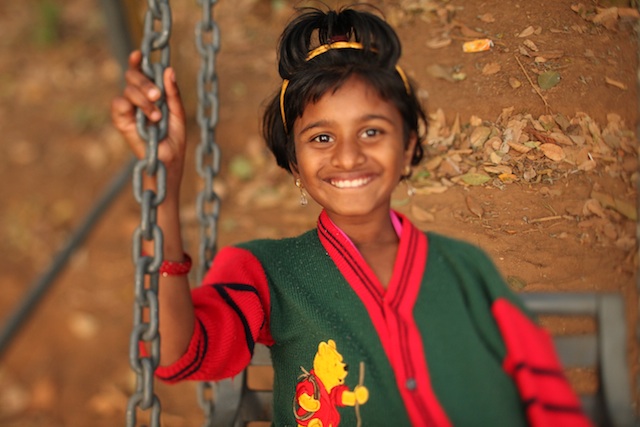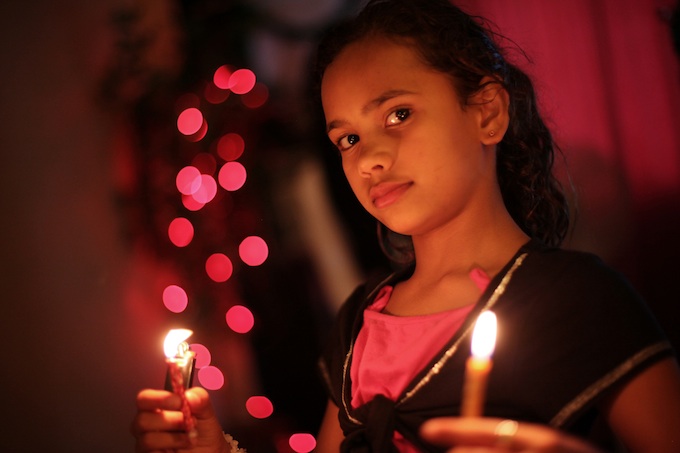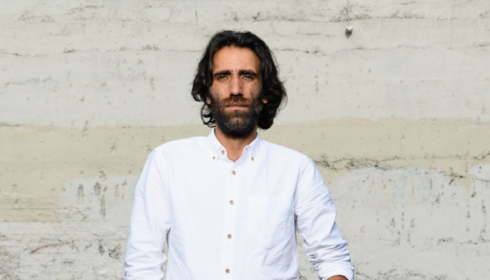
[RN]: Your film is a multi-layered portrait of what it means to be 11, and you interviewed children from around the world to create it. Why did you choose the age of 11?
[Genevieve Bailey]: I chose 11 because I thought back to my favourite age in life – when you’re full of ideas and personality and you know what you’re really passionate about, and that for me was when I was 11. I was very curious to explore what it would be like to be 11, but rather than just shooting it here in my own backyard in Australia I wanted to shoot it on a global level and to involve stories from all over the world. I wanted to create a film that was going to be positive and optimistic and at that age in life kids express a lot of their personal views; they show a lot of courage and hope as well as optimism for the future. So I wanted to create a platform that would enable children around the world, who I found very insightful and inspiring, to share their voice with a global audience.
One of the best things about your film is that it allows children’s voices to be heard. This right for children to be heard is still often overlooked by governments and in law courts. The children in the film seem to love having the chance to be on camera and be interviewed. How important was it for them to have their voices heard?
I think it’s worth noting that I didn’t go out trying to find kids who were particularly articulate or very confident or expressive. I actually just found a really random selection of children in a very organic way. I didn’t try and find the kids that had the best grades at school or the kids who wanted to be on camera as such, who were interested in performing. I actually found a very random sample of kids and it’s testament to the age that at 11, these kids did want to have their voices heard. For me as a director the important thing was to make sure the kids were comfortable and that at all times they felt they had the freedom to express themselves however they wanted to. We didn’t go in there and have a big crew and have anything intimidating forced upon them. All the kids wanted to be involved.
They were very proud to have this opportunity to express themselves. Every single time I had a shoot it would amaze me how articulate and insightful the kids were. I became inspired by this – it was the kids who inspired me to continue making the film for so many years. Because these children were worth listening to. I thought “Yeah, it’s worth investing a lot of my time and energy and money into making sure that this film is as big as it can be.”
I didn’t want to put any pressure on them to make them think that they had to speak on behalf of their nation because really – whether you’re a child or an adult – who can do that?
I made it really clear to each of the kids that they weren’t speaking on behalf of anyone but themselves – they weren’t there to represent their country, they were there to represent themselves. Sometimes we’d have translators or interpreters who would say to them “Oh, you’re representing your country now, so make sure you say the right thing.” And I would say very quickly “No no no, they’re only representing themselves – their views and their opinions.” I didn’t want to put any pressure on them to make them think that they had to speak on behalf of their nation because really – whether you’re a child or an adult – who can do that? People will say, “Did you try and find ‘typical’ kids?” Well what’s a typical Australian? What’s a typical Swedish person? What’s a typical Chinese person? I don’t like putting people into boxes like that – especially children.
I Am Eleven features children from 15 different countries. How were you able to find these children to interview?
I would land in a new city and more often than not I wouldn’t know anyone there. So I’d basically try and find the kids in a really random way. I didn’t go through schools – that would have been the easiest option but I decided that I was finding such great personalities by doing it randomly that I thought “No, I’m going to stick with this procedure of hitting the streets, going to marketplaces, talking to pas in shops or walking around, meeting the locals and asking them ‘Do you know anyone who is 11?’”
It’s a great age when you’re 11. Your blinkers are off and you’re curious about the world, but you’re not scared of what’s different – you tend to celebrate and be interested and intrigued by that.
It sounds kind of funny to people when I say that, but I just became so used to doing it. A part of my daily grind was putting in the legwork to try and find someone. I basically had three rules. My first rule was that they had to be 11; my second rule was that they had to want to be involved; and the third rule was that the parent or guardian gave permission for them to be involved.
Some children in the film share their thoughts on bullying and love. The French boy, Remi, in particular, makes some insightful comments about the state of the world and he is acutely aware of his position of privilege – he knows that many children in the world do not live the way he does. Overall, how great was the sense of injustice and human rights in the children you spoke to?
I think the understanding and awareness of it for children that age was actually very broad and very strong in most of the places I went to. Remi articulates himself so well – from his understanding of political issues and immigration to his understanding of love. For him, there’s three different types of love – there’s love you have for your family, there’s love you have for people who are your friends and who would be there for you when you need them, but also this other love for people you’ve never met who are also human – you feel for them and their struggles.
That was really amazing and audiences have been commenting on how mature he was and how his ideas were more profound than many of the people that we hear speaking on the world stage. Someone came out of the film recently and said “That film has to be shown to all world leaders so that they can learn from these kids.” And we’ve had audiences say “If only the world was run by 11-year-olds!” I really do think that this film encourages children to come along and hear from their peers, but also adults to stop for a moment and reflect on the fact that we were all 11 at one point. There’s a certain sense of clarity and a lack of ego when you’re that age and a feeling for your fellow brothers and sisters around the world even if you’ve never met them.
That’s what really inspired me about so many of the kids and their stories – that they were really aware of their fellow children around the world and they were excited to have a very real way of communicating with them. Even if they were never meeting them in real life they were able to communicate through the film.

Vandana: Photo credit Henrik Normstrom
Some children in the film are still very much children, but others, because of their circumstances, are required to do things that we in the West would assign to adults – some 11-year-olds in India have to care for the younger children in the orphanage, for example. Were you shocked by the distinctions between the lives of these 11-year-olds across continents and in comparison to your own memories of being 11?
I wouldn’t say I was shocked but I would say I was impressed. In India, in particular, I was so impressed that the kids were waking up an hour earlier than they needed to so that they could be first in line to iron their school uniform. Even though they didn’t have many possessions at the orphanage they took real privilege in the fact that they had a school dress and they were going to iron it and make sure it looked nice. And they also get up early so they could help get their little brothers and sisters ready for kindy or for school. That was very impressive to me.
The kids in India, along with lots of the kids, taught me a lot about resilience. As a filmmaker in this country and other places in the West it’s very easy to get into the habit of complaining about how hard it is to get film funding and how hard it is to get a film made, and even though I acknowledge both those things are true, I think at the end of the day if I’m in a position where I can turn the kitchen tap on and have a drink of water, or even buy a bottle of water when I’m out, if you’re in that position then you are actually pretty wealthy. There are many people around the world who have to travel several hours to access clean water.
I think that the kids summed it up so well that I didn’t feel like I … needed to narrate the ending. I wanted the kids again to speak for themselves.
I think, for me, shooting kids in a diverse range of backgrounds helped me remember that we are pretty lucky over here, even though there’s a lot of people in Australia who are struggling – I acknowledge that as well – these kids in India were willing to get on with things and focus on the positives and have big hopes and big dreams for the future. I think that was a really great thing for audiences to take away from the film.
We had a kid in the audience last week who put her hand up and said “You’ve seen kids all over the world, where are the kids happiest?” And I said “What do you think? Where do you think they look the happiest?” And she said “India!” It’s amazing – we had some kids who think “I’m so lucky that I’m not in an orphanage” and then you have kids who think “They’re having fun! They look really happy.” They don’t have any of the stuff that lots of kids here acquire or might strive to acquire, but they have each other and they have a deep sense of community.
Jamira, the girl from Australia, is of Aboriginal heritage. She is proud of her culture but hasn’t had the opportunity to learn her language. What did you find most fascinating about your interview with her, considering her understanding about the rights of Aboriginal people in Australia, and the rights of refugees, who she lives close to?

Jamira: Photo credit Henrik Normstrom
Jamira was such a breath of fresh air. Coming back to Australia, I wanted to make sure that I didn’t shoot an 11-year-old here that I already knew. I thought “No, I want to give myself that same challenge of starting up a relationship with an 11-year-old here who I don’t already know”. I met Jamira quite randomly which was great. From the day I met her, it became obvious that she was proud of who she was. Like she says in the film, she likes being different, she likes that she’s not the same as everyone else.
She’s different and her friends are different; they’re really cool with that and they have a lot of confidence in each other as a community.
Jamira, who lives in inner-city Melbourne, has got friends from all over the world and like she said a lot of her friends are from refugee backgrounds, a lot of the kids are from Africa and the Middle East. It’s interesting to see a story of a girl with an Aboriginal background who is living in an urban environment, who is the only Christian at her primary school pretty much, aside from a couple of Chinese kids. It was great to get to know Jamira and her peers. She’s different and her friends are different; they’re really cool with that and they have a lot of confidence in each other as a community.
I think as Jamira gets older, she will travel more around Australia. She has already done that in the last year and met up with some of her cousins and some of her relatives up north who are from the same area where she was born. It’s great seeing Jamira grow up and feel really empowered by who she is and her culture and I think she’s the sort of girl who, like most of the kids in the film, or all of them, whatever she puts her mind to I think she’s going to succeed in life. I think she’s really interested in setting the bar high for herself and achieving all her goals. It’s great that she has the support of her dad and people around her who really encourage her to be whoever she wants to be.
More generally, what do you think is the role that film plays in terms of social change?
I think it’s an extremely powerful way of creating social change and awareness. I’ve always believed that there’s so much misunderstanding in the world and so much war and conflict comes from fearing the unknown. I think my films, regardless of whether they’re comedy or drama or documentary – can promote tolerance and understanding in many different ways.
I became really encouraged by that, as a filmmaker, my stories could make a difference. I grew up in Melbourne with friends from Fiji, Greece, Sri Lanka, Argentina, and Ireland – even though I went to a very small school I had friends from all over the world. It was great. I learnt so much about these cultures from a young age. Whereas there are many people who perhaps live with parents who are prejudiced or racist, or who live in an area where they don’t get to meet people of different faiths and different backgrounds. If I can make something that shows all these charming kids, and allows us to experience their lives and their world and engages audiences, that will encourage more understanding and tolerance of difference.
It’s a great age when you’re 11. Your blinkers are off and you’re curious about the world, but you’re not scared of what’s different – you tend to celebrate and be interested and intrigued by that. As a filmmaker if you can create something that allows someone to step into someone else’s shoes to a certain extent, and explore their world and be encouraged and inspired by that, rather than fearing the unknown –that’s what makes me excited about being a filmmaker.
At the end of I Am Eleven, you go back to interview some of the children when they are no longer 11. What did you find was the main change for them?
It was really insightful for me, as an individual as well as a filmmaker, to go back and see them when they were growing up. Billy was 12, turning 13, and there were remarkable changes already – he was so much taller and talking about growing a moustache. Originally I’d planned to make the film when they were 11 without necessarily including the older stories. But hearing them speak, and hearing Grace speak about how she felt she’d changed, I thought including these newer stories really reiterates the underlying thesis of the film – that 11 is this special age and it’s a cusp; it’s before you’re a teenager but you don’t feel like a little kid any more.
So I think including those older stories for me was really interesting – like Grace says, “When you’re an adult, you’re not mean, but you’re just a bit more cautious about things, whereas when you’re a child, you don’t have anything to hide”. And I think that the kids summed it up so well that I didn’t feel like I, as a filmmaker, needed to narrate the ending. I wanted the kids again to speak for themselves. I feel very passionate about this film being through the eyes of these kids, and of course I’ve made it as a filmmaker and I’m not 11. But I tried to make sure that all times the kids were taking the lead – they were my guide, rather than the other way around.
I am passionate that children have a great foundation and are allowed to be kids as kids. I think that is so important. I think it really sets you up well as an adult if you’re childhood was something that you think was a positive experience where you felt respected and empowered. Unfortunately so many kids don’t have that right – which is a basic human right – so we’re trying to do what we can to help platform these voices and encourage people to not forget how important these voices are and to give kids an opportunity to be involved and express themselves within each community.


